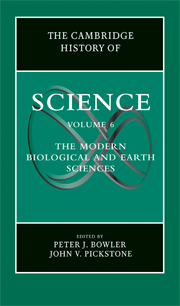Book contents
- Frontmatter
- 1 Introduction
- PART I WORKERS AND PLACES
- PART II ANALYSIS AND EXPERIMENTATION
- PART III NEW OBJECTS AND IDEAS
- 20 Plate Tectonics
- 21 Geophysics and Geochemistry
- 22 Mathematical Models
- 23 Genes
- 24 Ecosystems
- 25 Immunology
- 26 Cancer
- 27 The Brain and the Behavioral Sciences
- 28 History of Biotechnology
- PART IV SCIENCE AND CULTURE
- Index
- References
20 - Plate Tectonics
from PART III - NEW OBJECTS AND IDEAS
Published online by Cambridge University Press: 28 November 2009
- Frontmatter
- 1 Introduction
- PART I WORKERS AND PLACES
- PART II ANALYSIS AND EXPERIMENTATION
- PART III NEW OBJECTS AND IDEAS
- 20 Plate Tectonics
- 21 Geophysics and Geochemistry
- 22 Mathematical Models
- 23 Genes
- 24 Ecosystems
- 25 Immunology
- 26 Cancer
- 27 The Brain and the Behavioral Sciences
- 28 History of Biotechnology
- PART IV SCIENCE AND CULTURE
- Index
- References
Summary
The earth sciences underwent a revolution during the 1960s, ending nearly sixty years of controversy over the reality of continental drift. Before 1966, few workers accepted continental drift as a working hypothesis; most earth scientists preferred fixist theories. Fixist theories maintain that the continents and oceans have not appreciably changed their positions relative to each other, whereas theories within the continental drift tradition, hereafter referred to as the mobilist tradition, maintain that relative displacement occurs. However, most earth scientists became mobilists soon after the confirmation of seafloor spreading, and plate tectonics, the modern theory of continental drift, remains the reigning theory in the earth sciences. The aim of this chapter is to outline the major historical aspects of the plate tectonics revolution.
THE CLASSICAL STAGE OF THE MOBILIST CONTROVERSY: FROM ALFRED WEGENER TO THE END OF THE SECOND WORLD WAR
The prospect of finding an overall geological theory looked promising to many earth scientists during the 1880s, for they believed that Eduard Suess (1831–1914), the great Austrian geologist, had provided them with a basic framework. His fixist theory was secular contractionism, the reigning tradition during the latter half of the nineteenth century. Suess maintained that the earth has been contracting since its initial formation as it cooled. He postulated that tensions are produced in the crustal layer because the earth’s inner layers contract more rapidly than its crust.
- Type
- Chapter
- Information
- The Cambridge History of Science , pp. 383 - 394Publisher: Cambridge University PressPrint publication year: 2009
References
- 1
- Cited by



